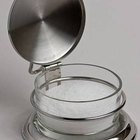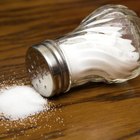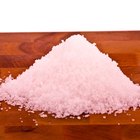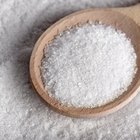
You likely eat salt every day. Salt is in the food you buy and in your own cooked meals (you do add salt, don’t you?). What you may not know is that the salt used in these foods or the table salt in your home may be one of two types: non-iodized salt or iodized salt. These salts differ in chemical content, in health benefits and, to an extent, their effects on the flavor of food.
Production
Producers of salt have many different ways of manufacturing salt. Regardless of how salt producers create their salt, the final product, the mineral with the chemical composure of NaCl, is called non-iodized salt. Iodized salt is produced no differently than is “salt.” The main difference in these two types of salt comes from the addition of an iodide or iodate compound. It is only this post-production addition that differentiates salt and iodized salt.
Health
In terms of health, iodized salt has a clear advantage over that of non-iodized salt. In many countries, especially Third World countries, iodine deficiency is common. By introducing iodized salt and having it replace normal salt, public health officials are employing a valuable measure that prevents goiter, mental retardation and other adverse health effects. However, in many developed countries, where iodine deficiency is rare, the health advantages of iodized salt diminish because those living in these countries simply do not need the extra iodine that iodized salt provides.
Taste
Many cooks and workers in food preparation adhere to the belief that iodized salt has poor flavor when compared to non-iodized salt. At the same time, other members of the food industry disagree, stating that there is no flavor difference between the two salts. Scientific studies have investigated whether iodized salts change the flavor of food items. The results of many studies show that the effect of using iodized salt in place of non-iodized salt is small to negligible. These studies conclude that iodized salt does have a slightly different flavor from non-iodized salt, but that it does not affect the food that it is seasoning to a large degree. This is because the mechanism by which iodized salt changes a food’s flavor is iodine absorption. Most foods absorb little iodine when cooked with iodized salt, although some foods tend to absorb more than others (pasta and rice, for example).
Color and Texture
Chefs from all over the world have stated that using iodized salt in place of non-iodized salt changes the color and texture of the food prepared. For example, chefs from Canada, Romania, Pakistan and the U.S. have commented that iodized salt is unsuitable for pickling. These chefs have stated that applying iodized salt to pickling concoctions have led to the darkening and softening of pickled food items. However, no scientific studies have investigated these claims as of yet.
Related Articles

Low-Potassium Salt Substitutes

What Is a Salt Cellar?

What Is Gray Salt?

How to Find a Salt Substitute Without ...

How to Make Salt Brine

How to Finely Grind Celtic Sea Salt

Uses of Saltpeter in Food

What Is Accent Seasoning?

How to Use Sea Salt for Canning

Nutritional Facts of Fava Beans

Nutritional Information for Johnny's ...
A Saltpeter Substitute for Curing Ham

What Is the Difference Between Salt ...

Salt As an Insecticide

The Effect of Salt on the Tenderness of ...

Difference Between Rock Salt and Sea ...

How to Clean Salt Stains From Suede

Accent Seasoning & Its Benefits

How to Do a Salt Covenant for a Wedding ...

Vegetables That Contain Salt
References
- “Effect of Iodized Salt on the Color and Taste of Food”; Clive West and Richard Merx; 1995
Writer Bio
Having obtained a Master of Science in psychology in East Asia, Damon Verial has been applying his knowledge to related topics since 2010. Having written professionally since 2001, he has been featured in financial publications such as SafeHaven and the McMillian Portfolio. He also runs a financial newsletter at Stock Barometer.
Photo Credits
Jupiterimages/Photos.com/Getty Images